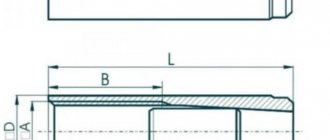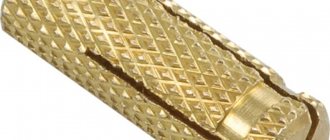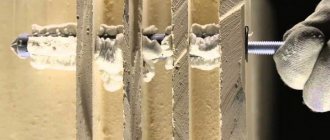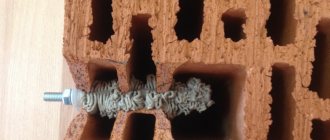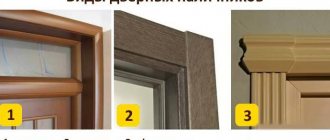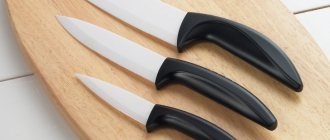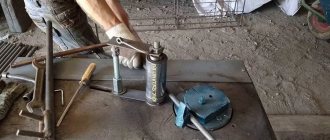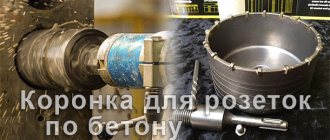Fastenings using various types of anchors are characterized by specialists as connections that can provide reliable retention of heavy loads. After deepening into a pre-prepared hole, the worker, depending on the tasks at hand, chooses the best way to fasten the anchor bolt. After the assessment, when the selected surface areas are suitable for organizing a point that provides fastening of anchor devices, the point is arranged with subsequent fastening of the equipment.
The use of anchor supports is necessary when using a rope movement system when carrying out installation and construction work at height, fixing slings for positioning and holding the worker without slipping and jerking. The strength of the connection allows the use of anchor points and lines to ensure the installation of collective and individual protective equipment, making it possible to safely carry out installation work on products and maintenance of devices located at height.
Anchor - classification and scope of use
According to unconfirmed statistics, it is believed that Russia is capable of absorbing about 15 thousand tons of all kinds of anchors in one quarter, which is only three months. Our mounting element is almost at the top of this list. This is explained simply: this type of fastener is made so popular by its technical characteristics and a fairly wide range of applications.
But initially, such fasteners were intended for attaching window frames and door frames to a concrete and brick base. It is thanks to its purpose that such a dowel received the “frame” classification. Today, fasteners correspond to their immediate technical characteristics, and most of this type of dowels is used for installing metal-plastic windows and door frames made of various materials.
But thanks to its versatility, the use of the anchor did not end with the above tasks. As it turned out, such fasteners were ideal for mounting wooden beams and slats to various bases. For example, it is very convenient to use such an anchor when installing a wooden beam when installing a floor on a small area; in practice, it could be an ordinary balcony block, the floors of which you want to make of wood.
How to install
To carry out installation work, you must have the following tools:
- Hammer.
- Phillips screwdriver.
- Hammer.
To install a window frame, you need to perform several technological steps. Moreover, they all must take place in a certain sequence:
- First you need to install the frame on the spacers.
- Then the frame is aligned relative to the horizontal and vertical.
- For fixation, the frame is secured on each side with wedges, which are driven tightly with a hammer.
- The attachment points are marked. To do this, measure 30 cm from the upper corner and apply the first mark. The same steps are repeated with the lower part. The indicated size is a recommendation. If necessary, it can be increased or decreased.
- A through hole is drilled in a wooden frame. An anchor is inserted into it and tightened with a screwdriver. Expansion of the fastener occurs on several sides. The upper part is expanded by a cap, the lower by a cone-shaped nut.
- At the finishing stage, all the resulting cracks are carefully sealed with high-quality polyurethane foam.
If the installation of the frame anchor is carried out in compliance with all technological requirements, we can talk about creating a reliable fastening of the window frame. Such a part can withstand enormous loads. It will create a strong connection between parts made of different materials.
Frame metal anchor - making the right choice
Let us assume that you have already decided for what purposes you need fasteners, and now all that’s left is to buy the necessary part and carry out installation. But the choice of mounting bolts is also a crucial moment, especially since currently there are a large number of low-quality products, and if this concerns anchor fasteners, then we definitely need to take into account some points, namely:
- The material from which the fastener is made. The anchor can be made of various metals, as a rule, it can be ordinary steel, galvanized steel, stainless steel, and also brass. Depending on the application environment, you need to select the appropriate fastener.
- Hairpin length. In each individual case, the length is determined based on the tasks that the fastener must perform.
- Spacer quality. This is perhaps the main technological parameter of the entire fastener. The thickness of the bushing, based on existing requirements, must be at least 0.8 millimeters, and if the thickness of the metal of the bushing is less, you risk getting a poor-quality fastening.
Operating principle and design features
The technical capabilities of a frame anchor are determined by the features of its design. When choosing a frame metal anchor for installation work, you should take into account the fact that it is not designed for significant loads and the large weight of objects secured with it. The weight of an object fixed on a vertical surface using one anchor of this type cannot exceed 30 kg.
Frame anchor device
The main structural element of a frame anchor bolt is a metal sleeve with longitudinal slots that form peculiar petals that open during installation of the fastener. A cone nut is responsible for opening the petals on the side of the bushing. It, screwed onto the main rotor, acts on the inner surface of the sleeve with slots, thereby unclenching it. The bushing, having increased in diameter, engages tightly with the inner walls of the mounting hole, securely locking into it.
To make it more convenient to manipulate the screw screwed into the spacer sleeve, there is a head with slots for a shaped screwdriver on its upper part. A special feature of the frame anchor is that its head is completely recessed into the mounting hole, so the side surface of its head has a conical shape. When using such fasteners, you should not only drill holes for their placement, but also provide a special “sunk hole” into which the bolt head will fit.
The use of screwdrivers with a shaped working part for installing frame anchors makes this process convenient and allows it to be carried out effectively even in hard-to-reach places.
The frame anchor for hollow structures has an enlarged spacer zone (butterfly) and a flat-shaped nut that works to tighten
Rules for mounting the fastening element
Let's now look at the basic rules for installing our dowel using a specific example. After all, compliance with all technical conditions for installing the anchor determines how the structural element we have secured in the future will hold, be it a door frame or a wooden beam on which we are going to hang a heavy carpet. First of all, we need to prepare the tool with which we will carry out the installation.
To do this, we will take a hammer drill, a drill for it, with a diameter of 8 millimeters, and we will also need a Phillips screwdriver to tighten the fastening pin, and also prepare a hammer, we cannot do without it. As an example, we will look at installing a window frame and then using our frame fasteners. So, let’s get started and go through all the steps of installing a window unit step by step.
Selection rules
When choosing a frame-type anchor bolt, you should take into account not only the size of the object being mounted with it, but also a number of other parameters. The difficulty in choosing such a fastener also lies in the fact that on the modern market there are products that are of very low quality.
In order not to find yourself in a situation where the purchased window anchor bolt does not suit you according to any parameters, when choosing it you should focus on the following factors.
- Carbon steel and brass are predominantly used as materials for making frame anchors. When choosing a fastener made of carbon steel, you should pay attention to the presence of a zinc coating on its surface, which protects the fastener from corrosion. Bolts made of brass, which is a less durable material than steel, are chosen for mounting less critical and not too heavy objects.
- The choice of frame anchor dimensions (length and diameter of the threaded rod) depends on the weight of the product you are going to fix with fasteners. The greater the weight of the item, the longer and thicker the threaded rod should be.
- The manufacturing quality of the spacer sleeve is an important parameter that should be paid special attention to. According to all the rules for the manufacture of frame anchors, the wall thickness of such a sleeve should not be less than 0.8 mm. Otherwise, there is no need to talk about the quality and reliability of such fasteners.
The dimensions of the frame anchor, such as the diameter of the spacer sleeve and the length of the threaded rod, are specified in the provisions of the regulatory documents. The most common diameter of the anchor frame bolt sleeve is 8 mm; this size is considered the most universal. In some cases, when it is necessary to ensure greater reliability of fixation, anchors with a stud with a diameter of 10 mm are used, which are capable of withstanding significant static and dynamic loads.
As for the length of the hairpin, it is also standardized by the provisions of the relevant standard. The length of the stud of frame anchors produced by modern industry starts at 72 mm, and the maximum value of this parameter corresponds to 172 mm.
The drawing shows the parameters of the frame anchor. Their numerical values are given in the tables below
Technical characteristics of frame anchors with a diameter of 8 mm
Technical characteristics of frame anchors with a diameter of 10 mm in various lengths
The effectiveness of using anchor bolts is also ensured by the quality of the material in which they are mounted. So, if the material of the structure into which the anchor is installed is solid and has a dense structure without internal defects, then the fastening will be reliable.
How to properly install the fastening element - step-by-step diagram
Step 1: Install the frame into the opening using spacers
Before you start drilling holes and permanently securing the window block, the frame itself must be correctly positioned on spacers, align the window block relative to the vertical plane and, accordingly, the horizontal one. To do this, we use pads under the frame and wedge the frame on both sides with wedges. We hammer the wedges in as tightly as possible so that the frame stands firmly in the window opening. The building level will help us check the evenness. If deviations are observed, then with light blows of a hammer we remove these defects, moving the frame in the desired direction.
Anchor fastening types and features of anchors application tightening technique
Using a kit for fastening to anchor supports, it is possible to install the coupling on power transmission line supports and wind the free length of the optical cable onto the frame. This type of connection is used to ensure the safety of work performed at height according to the permit. To carry out such activities, a permit is required, issued by a labor protection specialist and endorsed by officials from among the managers, and the work itself is carried out by a group of workers under the guidance of foremen and supervisors.
The most widely used are anchor bolts that have a spacer operating principle based on the expansion of the rear section of the sleeve when a cone-shaped sleeve is screwed into it. Among the well-known types of anchors, experts call driven, expanding, chemical, expansion and wedge structures. Each of them ensures reliable retention of the fastening part due to the use of the friction force between the contact surfaces of the bolt and the installation area, the thrust force, which ensures compensation of the effective stress by the resistance of the metal of the product. Increasing the diameter of the spacer sleeve when screwing a bolt into it ensures a reliable connection due to the combined action of thrust and friction forces.
Experts emphasize the importance of choosing the right type of anchor, based on studying the manufacturer’s documents that determine the specifics of each type of product. since the reliability of the system largely depends on the building material used at the point where the bolt is attached. Proper execution of fastening is necessary to prevent damage during operation of the parts that make up the connection and to ensure comfortable work in the support. Such a connection will ensure safety when working at heights, fastening heavy static (horizontal bars) and dynamic (diamond drilling rigs) structures.
Calculation of anchors
Performing a pull-out test on connections is often performed on site. The permissible load will depend on the base material, for example:
- When installing massive structures at height, the required tensile strength should be about 700 kg, which is why experts recommend using chemical types of anchors for such fastenings.
- When using concrete or brick as a base, the average load is about 350 kg, this value is sufficient for fastening medium and heavy structures.
- When using foamed concrete, the load it can withstand will be about 250 kg.
In addition to calculating the load-bearing capacity of the elements used, the correct tightening torque of threaded connections must be ensured. If the tightening is insufficient, there may be no frictional force in the connection; if the recommended values are exceeded, there is a possibility of material destruction due to excess pressure on the base.
Did you manage to solve your problem using the recommendations from the article?
Yes!
46.84%
No. More answers required. I'll ask in the comments now.
37.31%
Partially. There are still questions. I'll write in the comments now.
15.85%
Voted: 713
Types of anchor fastening
As noted above, the correct choice of location for the anchor point plays an important role in ensuring worker safety. It is possible to assess when the selected areas are suitable for installing anchorage points by the load they can withstand; each of them must withstand a weight of at least 22 kN. To ensure reliable connection, the anchor point used to fasten the equipment can be connected to the load-bearing elements of the building, pre-assembled metal structures. After drilling the hole and installing the anchor, kits are used to secure the safety structures to the anchor supports. The standard kit used for anchor type fastening includes:
- 3 anchors;
- threaded rod;
- punch for making a recess;
- nuts that require the use of an open-end wrench.
Additionally, the kit used for fastening to anchor supports may include a washer and a punch to ensure wedging when using an anchor of the appropriate design. In addition, a kit for anchoring may include a larger number of bolts, but in this case the cost of one set increases. The kit that provides fastening of security systems to anchor supports includes an anchor clamp, a small steel cable, wedges and a bracket that allows for the installation of up to 3 clamps.
Structurally, an anchor bolt with a nut is a stud with a thread on one side, with which the nut is screwed on, and the other end is made in the form of a spacer cone. When tightening the nut, the spacer-type sleeve, on the side surfaces of which there are slots, expands, forming “petals” that ensure a reliable connection with the support surface.
Note! Before attaching anchor bolts, the concrete surface is drilled, and the drill, with the exception of cases of impact-type bolts, corresponds to the diameter of the anchor used.
Anchors used to fasten parts of geogrids are mounted around the perimeter of each of the mounted modules. The anchor for fastening the geogrid is installed according to a pre-approved diagram, so that the tension lines provided resemble a rectangle.
Manufacturers place high demands on the quality of products, testing the elements for strength necessary to ensure safety, preventing their damage, breakage or failure. When using rope access systems, it is prohibited to use only one rope when ascending or descending planes, as well as when performing installation work. To ensure the safe operation of flexible anchor lines, the correct answer when asked by an instructor about the specifics of use is the need to use limiters at the end to prevent the descent from passing the end of the rope. Permissible impacts are determined by the effective load in the operating structures. In turn, workers receive a work permit by giving the correct answers after preliminary instruction.
Impact method
The use of this method involves the use of drive-in type anchors and is characterized by ease of installation and reliability of the resulting connection. However, the method has limitations regarding the possibility of using it exclusively when working with materials with high strength values, for example, concrete, solid brick or stone.
- Before attaching a drive-in anchor bolt, it is necessary to drill a hole whose diameter corresponds to the parameters of the bolt used.
- After this, it is necessary to clean the prepared hole from debris and dust.
- The next step is to install a hammer-type bolt into the hole.
- Using a hammer and other tools, such as a bit or a special wedging structure, the striker is inserted into the conical hole. At the same time, the sliding part of the bolt opens, providing support against the walls of the prepared hole.
- At the last stage, the parts are fastened using a pin or bolt.
